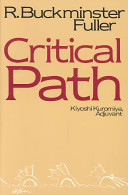The Privatization of Science
At this point the Wall Street lawyers and Strauss persuaded Eisenhower that the United States Bureau of Standards' scientists were in competition with private enterprise and must be curbed. Strauss assured Eisenhower that the corporations would take on all the bureau's discarded scientists. What the Wall Street lawyers' grand strategists realized was something momentous—to wit... that in the new 99.9-percent invisible reality of alloys, chemistry, electronics, and atomics, scientific and technical know-how was everything. Physical land and buildings were of no further interest to cap¬ italism. Metaphysical know-how was the magic wand of the second half of the twentieth-century world power structures. Physical properties were subject to deterioration, taxable, and cumbersome. Advised to do so by their lawyers, capitalism and private enterprise set about after World War II to monopohze all strategic technological know-how—i.e., all metaphysical properties—and to dump all physical properties. They called for an economic program by which people would be forced to buy the apartments and houses—to get all physical properties off capitalism's hands.
The post-Eisenhower era becomes most suitably identified as that of lawyer capitalism and of "no-risk," sure-thing, free enterprise.
The whole of atomic development was know-how. Scientists had the know-how, and anybody without their technical information could not even speak their language. The Know-How Club, monopolized by lawyer capitalism, was a very tight club. Furthermore, the nonmember four billion plus human beings on planet Earth knew nothing about the invisible micromacro, non-sensorially-tune-in-able reality. Large private enterprise had now hired all the know-how scientists and engineers. They seemingly could keep the public out of their affairs forever. The world power structure had the U.S. government completely emasculate the Bureau of Standards. There was an earnest and concerned battle by a few responsible scientists to keep the bureau intact, but they were overwhelmed. Henceforth all science must be done by the private corporations themselves or under their subsidized university-college and private laboratory work. To appreciate the extent of this know-how monopoly of the big corporations, one need only look over the wording of the scientist and engineering help-wanted advertisements of the big corporations^ in the many pages of The New York Times Sunday business section or of their counterpart publications in other big cities, s.
In the invisible, esoteric world of today's science there is no way for the American government or public, without the U.S.A. Bureau of Standards' scientists, to follow the closely held technical secrets of the big, profit-oriented corporations. To a small extent such popular journals as Scientific American help people follow details of this-and-that special case science without learning of the significance of the information in respect to comprehensive socioeconomic evolution.
No economic accounting books list metaphysical assets. Metaphysics is held to be insubstantial—meaning in Latin "nothing on which to stand." Patents can be granted only for special cases—i.e., Hmited physical-practice appHcations of abstract generalized principles, which principles alone are inherently metaphysical and unpatentable, being only "discovered" and not "invented." But physical patents are capital.
We have two fundamental realities in our Universe—the physical and the metaphysical. Physicists identify all physical phenomena as the exclusive manifest of energy: energy associative as matter or disassociative as electro¬ magnetic behavior, radiation. Both of these energy states are reconvertible one into the other. Because there is no experimental evidence of energy being either created or lost, world scientist-philosophers now concede it to be in evidence that Universe is eternally regenerative.
Notes:
After WWII, private enterprise took over science from the government, taking it away from the common person as well.
Folksonomies: history science culture capitalism
Taxonomies:
/law, govt and politics/government (0.480684)
/art and entertainment/books and literature (0.355243)
/science (0.242013)
Keywords:
Wall Street lawyers (0.901097 (neutral:0.000000)), private enterprise (0.890044 (positive:0.057200)), physical properties (0.715177 (negative:-0.381286)), United States Bureau (0.697759 (neutral:0.000000)), Metaphysical know-how (0.695706 (positive:0.532741)), lawyer capitalism (0.675990 (positive:0.661215)), twentieth-century world power (0.663516 (positive:0.532741)), Large private enterprise (0.661495 (positive:0.377566)), 99.9-percent invisible reality (0.659914 (neutral:0.000000)), technical know-how (0.658970 (positive:0.424966)), know-how scientists (0.654554 (positive:0.377566)), list metaphysical assets (0.651029 (neutral:0.000000)), private laboratory work (0.642111 (negative:-0.223956)), world power structure (0.641891 (negative:-0.496729)), Know-How Club (0.641196 (positive:0.396311)), strategic technological know-how—i.e. (0.637544 (neutral:0.000000)), know-how monopoly (0.632045 (positive:0.609997)), New York Times (0.623365 (neutral:0.000000)), Sunday business section (0.622890 (neutral:0.000000)), comprehensive socioeconomic evolution (0.621851 (positive:0.708294)), electro¬ magnetic behavior (0.620391 (neutral:0.000000)), Scientific American help (0.619451 (positive:0.708294)), engineering help-wanted advertisements (0.619285 (neutral:0.000000)), this-and-that special case (0.618831 (positive:0.708294)), economic accounting books (0.617284 (neutral:0.000000)), abstract generalized principles (0.615438 (negative:-0.288408)), Hmited physical-practice appHcations (0.614165 (negative:-0.288408)), metaphysical properties—and (0.574218 (negative:-0.397001)), Physical land (0.559456 (negative:-0.235805)), Science After WWII (0.556180 (negative:-0.315455))
Entities:
Strauss:Person (0.798394 (negative:-0.292127)), United States Bureau of Standards:Organization (0.794644 (neutral:0.000000)), American government:Organization (0.778159 (negative:-0.349237)), Eisenhower:Person (0.776276 (negative:-0.292127)), Bureau of Standards:Organization (0.637531 (negative:-0.496729)), U.S.A. Bureau of Standards:Organization (0.622033 (neutral:0.000000)), World War II:FieldTerminology (0.583686 (neutral:0.000000)), scientist:JobTitle (0.493042 (neutral:0.000000)), business section:FieldTerminology (0.448769 (neutral:0.000000)), The New York Times:PrintMedia (0.397808 (neutral:0.000000)), 99.9-percent:Quantity (0.397808 (neutral:0.000000))
Concepts:
Federal government of the United States (0.955017): website | dbpedia | freebase | opencyc
Capitalism (0.761380): dbpedia | freebase | opencyc
Private property (0.713768): dbpedia | freebase
World War II (0.689511): dbpedia | freebase | yago
United States (0.595894): website | dbpedia | ciaFactbook | freebase | opencyc | yago
Property (0.531845): dbpedia | freebase | opencyc
Science (0.506515): dbpedia | freebase | opencyc
United States Congress (0.498961): website | dbpedia | freebase | opencyc | yago





